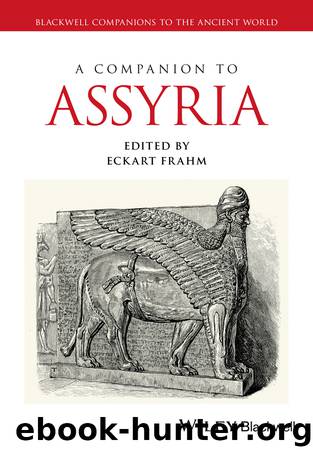A Companion to Assyria by Frahm Eckart;

Author:Frahm, Eckart;
Language: eng
Format: epub
Publisher: John Wiley & Sons, Incorporated
Published: 2017-06-19T00:00:00+00:00
Note
1 Because Assyria’s encounter with its southern neighbor was so formative for its civilization, the early history of this relationship is discussed here at greater length than Assyria’s early history with other regions is in this book.
CHAPTER 16
Assyria and the Far South: The Arabian Peninsula and the Persian Gulf
Eckart Frahm
Introduction
During the 12th century BCE, the complex state system that had emerged in Western Asia in the Late Bronze Age collapsed (see Chapters 6 and 8). The power vacuum left by this breakdown led to the rise of ethnic groups that had been heavily fragmented before but now began to metamorphose into cohesive political units, often organized along ethnic‐tribal lines. Besides the Phrygians, Hebrews, and Aramaeans, these groups also included the Arabs. The emergence of the Arabs as significant political players was primarily owed to the large‐scale introduction of domesticated dromedary camels in southern Syria and on the Arabian Peninsula around the turn of the millennium (Heide 2010; Sapir‐Hen and Ben‐Yosef 2013). Using camels allowed the Arabs to traverse stretches of desert that had been previously impassable and thus engage in a newly emerging international trade in spices and precious materials, as well as in super‐regional politics.
When the Assyrians, in the course of the ninth century BCE, expanded their military reach beyond the Euphrates River, they came for the first time into contact with groups of Arabs infiltrating the Levant from northern Arabia and the Syrian desert. Soon after, the Assyrians were interacting with Arabs on a regular basis, not only militarily but also politically and economically. A significant number of Arabic personal and tribal names are attested in Late Assyrian sources (Zadok 1981, 2013), and there are Akkadian loan words in Arabic and vice versa (Krebernik 2008). In the eighth and seventh centuries, especially during Assyria’s imperial phase, even regions further south, such as the kingdom of Sheba in modern Yemen, came into the purview of Assyria’s kings.
The following paragraphs provide a short overview of Assyro‐Arabian relations during the Neo‐Assyrian period. Assyrian interactions with people living in the region beyond the main deserts of the Arabian Peninsula are considered as well. The overview is mostly based on the testimony of Assyrian royal inscriptions, letters, and a few other cuneiform texts. Of the ca. 50,000 (mostly very short) pre‐Islamic inscriptions in Ancient North Arabian, only few seem to date to the Assyrian period, and the archaeology of northern Arabia is still poorly explored (for Dūmat al‐Gˇandal, see, e.g., al‐Muaikel 1994). The early rulers of Sheba in South Arabia left some more extensive texts, but none of them mention interactions with Assyria.
Download
This site does not store any files on its server. We only index and link to content provided by other sites. Please contact the content providers to delete copyright contents if any and email us, we'll remove relevant links or contents immediately.
| Africa | Americas |
| Arctic & Antarctica | Asia |
| Australia & Oceania | Europe |
| Middle East | Russia |
| United States | World |
| Ancient Civilizations | Military |
| Historical Study & Educational Resources |
The Daily Stoic by Holiday Ryan & Hanselman Stephen(3109)
The Fate of Rome: Climate, Disease, and the End of an Empire (The Princeton History of the Ancient World) by Kyle Harper(2870)
People of the Earth: An Introduction to World Prehistory by Dr. Brian Fagan & Nadia Durrani(2619)
Ancient Worlds by Michael Scott(2492)
Babylon's Ark by Lawrence Anthony(2428)
Foreign Devils on the Silk Road: The Search for the Lost Treasures of Central Asia by Peter Hopkirk(2385)
The Daily Stoic by Ryan Holiday & Stephen Hanselman(2343)
India's Ancient Past by R.S. Sharma(2294)
MOSES THE EGYPTIAN by Jan Assmann(2275)
The Complete Dead Sea Scrolls in English (7th Edition) (Penguin Classics) by Geza Vermes(2135)
Lost Technologies of Ancient Egypt by Christopher Dunn(2110)
The Earth Chronicles Handbook by Zecharia Sitchin(2100)
24 Hours in Ancient Rome by Philip Matyszak(1973)
Alexander the Great by Philip Freeman(1960)
Aztec by Gary Jennings(1877)
The Nine Waves of Creation by Carl Johan Calleman(1783)
Curse Tablets and Binding Spells from the Ancient World by Gager John G.;(1768)
Before Atlantis by Frank Joseph(1740)
Earthmare: The Lost Book of Wars by Cergat(1715)
